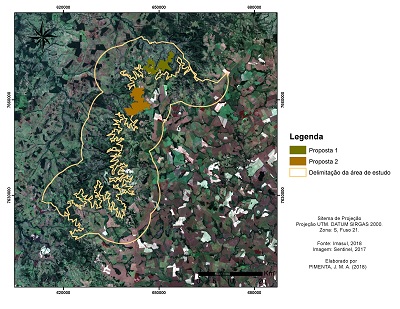Conservation Units through legal reserve compensation: evaluantion in Serra de Maracaju - MS
DOI:
https://doi.org/10.20873/jbb.uft.cemaf.v10n2.pimentaKeywords:
land regularization, public policy, creation of protected areasAbstract
One of the strategies adopted to preserve biodiversity in compatibility with the development of human activities has been the creation of Conservation Units. However, some Conservation Units are created without budgetary forecast to carry out the necessary expropriations and without an effective implementation process of these spaces, thus developing several land conflicts. In this sense, an important source of funds for the land regularization of Conservation Units has been the Legal Reserve Compensation provided for in the Forest Code, an instrument that has great potential to be used in the creation of protected areas. Given this context, prioritizing that the region has relevant importance due to its environmental characteristics, the research aimed to propose potential areas for the creation of Conservation Units in the Serra de Maracaju in Nioaque-MS through the Legal Reserve Compensation, aiming to alleviate conflicting situations in the creation of Protected Areas. The methodology used in the research was based on the analysis of data from the Rural Environmental Registry and through the data obtained from the use of geoprocessing techniques. The research results showed that the environmental compensation instrument combined with the Rural Environmental Registry is a potential generator of socio-environmental and economic benefits. Therefore, two Conservation Units were proposed in the municipality of Nioaque-MS.
References
Andrade MP, Santos EE. Unidades de Conservação no Brasil: algumas considerações e desafios. Revista de Extensão e Estudos Rurais, v.5, n.1, p.81-96, 2016. https://doi.org/10.36363/rever512016%25p
BRASIL. Lei Estadual n°18.295/2014 no art. 35 e no Decreto n° 2.711 de 04/11/2015, Instrução Normativa ICMBio nº5 de 19 de maio de 2016.
BRASIL. Decreto nº 13.977, de 5 de junho de 2014. Dispõe sobre o Cadastro Ambiental Rural de Mato Grosso do Sul; sobre o Programa MS Mais Sustentável, e dá outras provi-dências.
BRASIL. Deliberação Normativa COPAM nº 181, 05 de abril de 2013. Estabelece os procedimentos para formalização dos processos de regularização ambiental que têm por finalidade a compensação social de reserva legal mediante a doação de áreas em Unidades de Conservação de Proteção Integral pendentes de regularização fundiária no Estado de Minas Gerais.
BRASIL. Resolução SEMAC n° 08, de 15 de abril de 2008. Disciplina os procedimentos relativos ao Sistema de Reserva Legal – SISREL, instituído no Estado do Mato Grosso do Sul pelo Decreto Estadual nº 12.528, de 27 de março de 2008 e dá outras providências.
BRASIL. Áreas Prioritárias para Conservação, Uso Sustentá-vel e Repartição de Benefícios da Biodiversidade Brasileira: atualização Portaria no 9, de 23 de janeiro de 2007. Brasília: MMA, Secretaria de Biodiversidade e Florestas.
Coutinho Júnior JA, Oliveira FM, Gomes PIJ, Leite PDP, Batista SP, Campos ERT. O processo brasileiro de criação, implantação e manejo de unidades de conservação ambiental: o caso do Parque Estadual da Lapa Grande, em Montes Cla-ros – MG. Revista Desenvolvimento Social, v.18, n.1, p.123-134, 2016.
Lima BS, Silva CA. Serra de Maracaju: potencialidades para o turismo de natureza como alternativa turística em Mato Grosso do Sul. Caderno de Estudos e Pesquisas do Turis-mo, v.6, p.166-183, 2017.
Lima BS, Silva CAD, Boin MN, Medeiros RB. As paisagens e as dinâmicas territoriais na Serra de Maracaju, Mato Gros-so do Sul, Brasil. Cadernos de Geografía: Revista Colombi-ana de Geografía, v.29, n.1, p.224-241, 2020. https://doi.org/10.15446/rcdg.v29n1.75016
Lima BS, Silva CA, Boin MN. As paisagens da Serra de Maracaju/MS-Brasil, quando o olhar e a cartografia revelam o potencial do turismo de natureza. Revista da ANPEGE, v.14, n.25, p.6-38, 2018. https://orcid.org/0000-0002-1565-2250
Neves NR. Cerrado: uso do solo, conservação da sociobiodi-versidade e gestão integrada do território. In: Manejo e Con-servação de Áreas Protegidas. Viçosa, MG: Laboratório de Incêndios Florestais e de Conservação da Nature-za/DEF/EFV, 160p. 2014.
Pacheco R, Rajão R, Soares-Filho B, Hoff RVD. Regulariza-ção do passivo de reserva legal: percepção dos produtores rurais no Pará e Mato Grosso. Ambiente & Sociedade, v.20, n.2, p.181-200, 2017. https://doi.org/10.1590/18094422ASOC0012R1V2022017
Pimenta JMA, Batista RLM, Soares AJS, Moimáz M. Levan-tamento e representatividade das Unidades de Conservação instituídas no estado de Mato Grosso do Sul. Revista Prin-cipia, v.13, n.55, p.165-176, 2021. https://doi.org/10.24021/raac.v16i1/2.5152
Rangel L, Sinay L. Análise da Efetividade de Proteção das Unidades de Conservação do estado do Rio de Janeiro. Ter-ra Plural, v.13, n.1, p.106-123, 2019. https://doi.org/10.5212/TerraPlural.v.13i1.0007
Silva JS, Ranieri VEL. O mecanismo de compensação de reserva legal e suas implicações econômicas e ambientais. Ambiente & Sociedade, v.17, n.1, p.115-132, 2014. http://dx.doi.org/10.1590/1809-44220005580
Silva GBS, Mello AYI, Steinke VA. Unidades de conserva-ção no bioma cerrado: desafios e oportunidades para a con-servação no Mato Grosso. Geografia, v.37, n.3, p.541-554, 2018.
Silveira GB, Múniz STG. Pagamento por Serviços Ambien-tais: o caso da compensação de Reserva Legal. Revista de Estudos Ambientais, v.16, n.1, p.16-26, 2015. http://dx.doi.org/10.7867/1983-1501.2014v16n1p16-26

Downloads
Published
How to Cite
Issue
Section
License
Copyright (c) 2022 Jéssica Maia Alves Pimenta, Afrânio José Soriano Soares, Mineia Moimáz

This work is licensed under a Creative Commons Attribution 4.0 International License.
Copyright (c) 2024 - Journal of Biotechnology and Biodiversity

This work is licensed under a Creative Commons Attribution 4.0 International License.
Authors who publish with this journal agree to the following terms:
Authors retain copyright and grant the journal right of first publication with the work simultaneously licensed under a Creative Commons Attribution License (CC BY 4.0 at http://creativecommons.org/licenses/by/4.0/) that allows others to share the work with an acknowledgement of the work's authorship and initial publication in this journal.
Authors are able to enter into separate, additional contractual arrangements for the non-exclusive distribution of the journal's published version of the work (e.g., post it to an institutional repository or publish it in a book), with an acknowledgement of its initial publication in this journal.
Authors are permitted and encouraged to post their work online (e.g. in institutional repositories or on their website) prior to and during the submission process, as it can lead to productive exchanges, as well as earlier and greater citation of published work (Available at The Effect of Open Access, at http://opcit.eprints.org/oacitation-biblio.html).


